Cesar Cherem
comes from Minas Gerais (Juiz de Fora) where he keeps his greenhouse.
With an eclectic base, he is a dealer in watch trade, enterprise
manager, expert in marketing and business administration.
During his spare time, he cultivates his orchids having becoming
a well know grower of the bifoliate Brazilian species of Cattleya,
specially Cattleya loddigesii and Cattleya intermedia.
|
|
|
ON:
Why did you start to cultivate orchids? Which was the magic moment
of attraction?
CC: I have always been, since my childhood, connected to
seeds, trees and flowers. In 1983, I did a cultivation course with
Roland Cooke but only 10 years later I decided, by chance, to organize
and assemble some orchids plants I had spread on the trees in my
property. They were just four or five pots, hanged in a bamboo stick
under a tree.
|

C. harrisoniana coerulea 'Céu Azul'
|
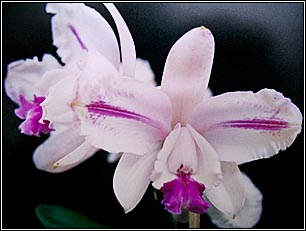
C. intermedia flamea '1115'
|
|
ON
- Besides this,
had you another influence (person or fact) ?
CC: By this time, there were no magazines or internet. I spent,
at least, two years looking for someone that could help me in cultivation.
I killed many plants to learn a little. The international shows
that anticipated the 1996 WOC have impressed me a lot. For someone
who was starting, without any knowledge, I found a treasure.
ON: How
long have you been cultivating orchids?
CC: At about 15 years.
|
|
ON:
How many plants do you have, approximately?
CC: I don't know exactly how many pots I have. May be 10.000 plants.
I also have many plantlets in flasks.
Besides seedlings with 1 or 2'.
|
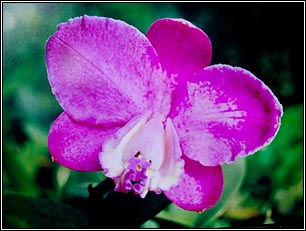 C.
loddigesii rubra '1115'
C.
loddigesii rubra '1115'
|
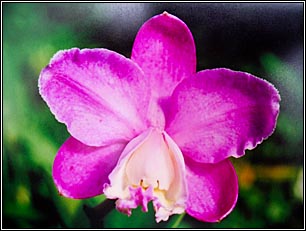 C. loddigesii
rubra # 2'
C. loddigesii
rubra # 2'
|
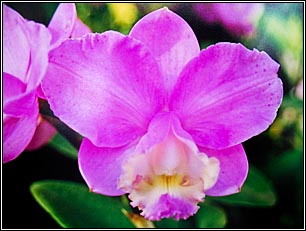 C. loddigesii
type '# 7'
C. loddigesii
type '# 7'
|
|
ON:
How
long do you spend taking care of your orchids daily?
CC: I live in an apartment, in the center of Juiz de Fora city
and my plants stay in my property 20km away. I go there to see them,
three times a week. I had a housekeeper just in charged to water
them, except for this, everything is done by myself: to plant, to
repot, to feed, to apply products to prevent or to treat pests and
diseases and everything else
I used to place plantlets in trays and pots, at night, in my house.
In my office, I receive my friends, letters, phone calls and e-mails
from another orchidists. At night, before going to bed, I find time
to contact friends from another cities and to read magazines, letters.
My time is shared between the work and the orchids.
ON: Do you prefer hybrids or species? Why?
CC: I prefer species. It is a big challenge to get high qualities
plants (form and colors). The plants coming from sowing bring fascinating
surprises, which motivate me a lot.
ON: Among
your plants, do you have a favorite one?
You are known by the quality of your cultivation, of your plants
and, specially, Cattleya loddigesii and intermedia.
Are they between your preferences?
CC: In fact, I have a few of everything in my greenhouse. I prefer
the bifoliate species: C.amethystoglossa, C. guttata, C.
harrisoniana and specially C. loddigesii and C.
intermedia.
I do have some preferences between my plants. Some have been cultivated
still in the flasks or are a gift from a beloved friend, some other
were difficult to buy.
|
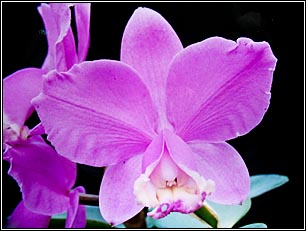
C.
loddigesii type 'Repouso do Guerreiro'
(The best plant in the National Show of Juiz de Fora - 2007)
|
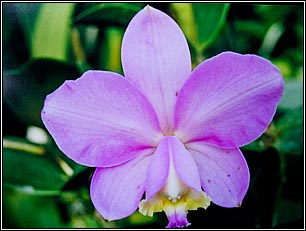 C. loddigesii
type 'Clarinha'
C. loddigesii
type 'Clarinha'
|
 C. intermedia
type '1115'
C. intermedia
type '1115'
|
|
ON:
What could you tell about your criterion to choose the plants and
how do you cultivate them?
CC: I choose my plants in the moment I buy them. When in blooming,
I look for the best form or for a different color, when seedlings,
by the historical of the matrices used in the cross.
I try to buy many plants from a same cross in order to do a selection.
Concerning the cultivation, nothing special: Peters 20-20-20 intercalated
with 15-5-15 +Ca and Mg, weekly, diluted in the water tank.
The great challenge is always cultivate plants from all around the
world in the same environment. It is important and fundamental to
know the characteristics and needs of every species and try to offer
them an environment and a cultivate as closest as possible of the
natural.
|
|
ON:
Which
are the climate conditions in your place?
CC: I keep my plants in green houses covered with plastic + shade
cloth which make possible the control of humidity, the application
of insecticides, fungicides and fertilizers. The region is very
humid and cold. I should wash the plastic twice a year to allow
a better luminosity. The walls are green as well as the shelves
and the pots which show how humid is the environment. I have many
trees and brooks close to the greenhouse.
|
|
ON:
Do you have
a cultivation tip to share with us?
CC: I use to say that there is not only one way to get success in
cultivation. It is important to adapt the best way inside the reality
of every one. Depending on the region or on the plants wanted, you
should chose the adequate substrate, chemical or organic fertilizer,
keeping plants hanged or laying in shelves, brief, always trying
to give them the most natural environment possible. I think it is
fundamental to keep humidity all year around. The great secret still
remains when water the plants, when water the floor or water the
walls. One day is always different from another. There is now a
foreseen day to water. This control is to me the great secret.
ON: But you have some good tips for cultivating Cattleya
walkeriana...
CC: It happens that my region is not the one of C. walkeriana,
it rains a lot and it is very humid. I only succeed to cultivate
them 2 years ago when I had my first covered greenhouse. Before
that, they rotted due to fungal diseases. The plantlets are kept
off the flasks and tied directly in small slabs of 'peroba', there
are at about 2.000 small plants thriving very well. Have a look
on the small plants rooting 30 days after replaced. The lost is
almost zero. After a year, approximately, they are planted in wood
baskets or in clay pots (photos), individually to grow until the
blooming. I also use small slabs of coffee tree which last less
than the 'peroba' but which satisfy the objective.This process of
cultivation walkeriana, where the collective pot is avoid, is a
result of the research done by my friend, Dr David. I have adapted
to my system and it is working well. He described his cultivation
with details in the bulletin of ACW year VII # 25 - January to March
2006.
|
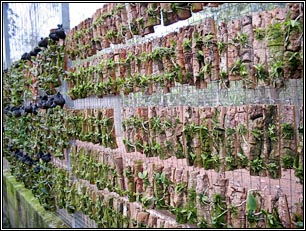 C. walkeriana
in 'peroba'
C. walkeriana
in 'peroba'
|
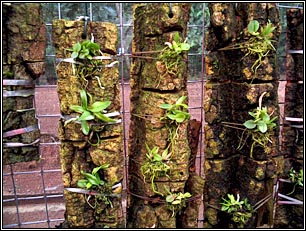 plants already
rooted in 'peroba'
plants already
rooted in 'peroba' |
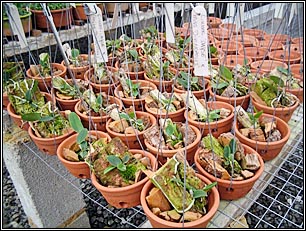 individual pots
individual pots |
 slabs of coffee
tree
slabs of coffee
tree |
|
ON:
Is there an interesting history or case connected to orchids?
CC: Three years ago, it happened to me something that I've never
could anticipate or imagine. I did an article about this fact. If
it was not sad, it will be funny.
In the blooming season of C. loddigesii, plants plenty
of buds, some blooming for the first time, cultivated since seedlings,
I got in the greenhouse and didn't find a whole bud. All of them
were chewed.
After an intense investigation, I found nests of loddigesii buds.
I installed mouse traps and succeeded in getting the criminals.
After that, I always advice who wants to cultivate orchids, include
a good mouse trap in the purchase list of pots, substrates, labels
and soon.
ON:
One said that orchidophilia is a soft manifestation of madness.
Have you done any "orchidophilic" insanity?
CC: The follies are so many that they become a routine.
To my family, I should go to a hospital. Let my family alone on
the beach to stay with plants, to travel all day around to visit
a show and come back immediately, those are some symptoms of the
"orchidinsanity", disease that every orchid lover has
in higher or in a lower degree.
ON: Thank you, Cesar Cherem.
Photos: Cesar Cherem
|
|